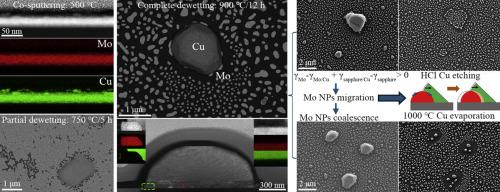Solid-state dewetting of co-sputtered thin Mo-Cu films accompanied by phase separation
IF 8.3
1区 材料科学
Q1 MATERIALS SCIENCE, MULTIDISCIPLINARY
引用次数: 0
Abstract
We employed magnetron co-sputtering to fabricate homogeneous Mo-Cu thin films on a heated sapphire substrate. Partial dewetting at 750–1000 °C led to the formation of Mo-Cu bicontinuous film and Cu particles. The Mo self-diffusion coefficient along the Mo-Cu interface at 750 °C was estimated at 1.8 × 10−14 m2/s from bicontinuous structure coarsening kinetics. After full dewetting at 900 °C for 12 h, isolated, closely spaced Mo nanoparticles and large Cu particles decorated with Mo nanoparticles were observed. Two orientation relationships between the Mo and Cu particles were identified, and the energies of the respective interfaces were estimated using atomistic molecular dynamics simulations. Selective etching of Cu exposed numerous Mo nanoparticles beneath each large Cu particle, while Cu evaporation at 1000 °C revealed fewer but larger Mo nanoparticles, indicating coalescence of Mo nanoparticles during Cu evaporation. We developed a semi-quantitative kinetic model describing the migration of Mo nanoparticles at the edge of a large evaporating Cu particle in terms of Mo self-diffusion on the exposed Mo surface and along the Mo-Cu interface. The driving force for Mo nanoparticles migration was estimated with the aid of atomistic simulations. Mo nanoparticles, dragged by shrinking Cu particles, increased in size by absorbing their smaller stationary counterparts beneath the Cu particle. The model-based estimate of effective Mo diffusion coefficient was in good agreement with the literature value of surface self-diffusion coefficient of Mo. Our findings provide new insights into the mechanisms of solid-state dewetting in binary immiscible thin films with vastly different component diffusivities.


求助全文
约1分钟内获得全文
求助全文
来源期刊

Acta Materialia
工程技术-材料科学:综合
CiteScore
16.10
自引率
8.50%
发文量
801
审稿时长
53 days
期刊介绍:
Acta Materialia serves as a platform for publishing full-length, original papers and commissioned overviews that contribute to a profound understanding of the correlation between the processing, structure, and properties of inorganic materials. The journal seeks papers with high impact potential or those that significantly propel the field forward. The scope includes the atomic and molecular arrangements, chemical and electronic structures, and microstructure of materials, focusing on their mechanical or functional behavior across all length scales, including nanostructures.
 求助内容:
求助内容: 应助结果提醒方式:
应助结果提醒方式:


